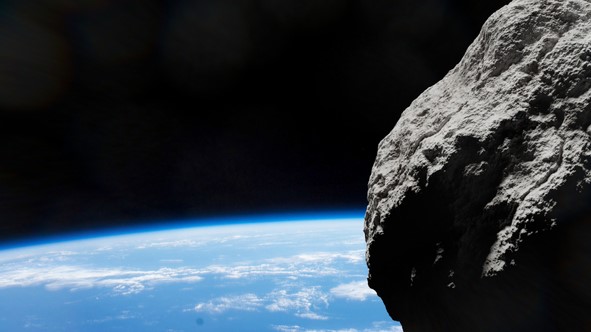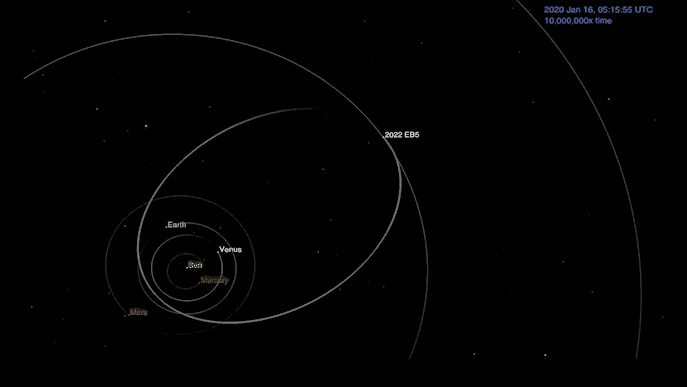Fridge-size asteroid detected just 2 hours before it slammed into Earth
It is only the fifth time that an asteroid has been detected prior to hitting Earth.

An asteroid as big as a refrigerator recently smashed into Earth's atmosphere just hours after it was first detected by astronomers. It is the fifth time that researchers have spotted one of these cosmic rocks before it hit us.
The asteroid, named 2022 EB5, was first detected by Krisztián Sárneczky, an astronomer at the Piszkéstető Mountain Station, part of Konkoly Observatory in Hungary, on March 11. Two hours later, the space rock, which measured around 6.5 feet (2 meters) across, slammed into Earth's atmosphere at an estimated speed of around 39,600 mph (63,700 km/h) and most likely exploded, according to EarthSky. Based on its speed, the rock was around one-third of the distance between the Earth and the moon away when it was spotted.
After the asteroid’s detection, NASA's "Scout" impact hazard assessment system began tracking the space rock. When it became clear that the asteroid would hit Earth, Scout automatically alerted the Center for Near Earth Object Studies (CNEOS) at NASA's Jet Propulsion Laboratory (JPL) in California. The CNEOS team predicted exactly where and when the asteroid would strike, according to a JPL statement.
"We were able to determine the possible impact locations, which initially extended from western Greenland to off the coast of Norway," Davide Farnocchia, a navigation engineer at JPL who helped develop Scout, said in the statement. “As more observatories tracked the asteroid, our calculations of its trajectory and impact location became more precise."
The asteroid hit Earth's atmosphere above Jan Mayen, an unpopulated volcanic island around 310 miles (500 kilometers) east of Greenland and around 370 miles (595 km) northeast of Iceland, at around 10:23 p.m. local time, just as predicted, according to the statement.
Related: The 7 strangest asteroids: Weird space rocks in our solar system
Witnesses in Iceland and Greenland reported seeing a bright light in the sky and hearing a loud noise, according to the New York Post. Experts think that they likely observed the asteroid as it became a fireball meteor, according to EarthSky.
Sign up for the Live Science daily newsletter now
Get the world’s most fascinating discoveries delivered straight to your inbox.
A fireball meteor is a type of extremely bright meteor that emits light equal to or greater than that of Venus in the night sky, according to the American Meteor Society (AMS). This is due to friction between the meteor and Earth's atmosphere, which heats up the rock and releases energy in the form of light. If the fireball meteor also explodes, it is called a bolide, and it can also create a sonic boom, according to AMS.

Even though our planet is hit with asteroids on a frequent basis, 2022 EB5 is only the fifth asteroid that has been spotted by astronomers before it collided with Earth; the first-ever Earth-impactor was spotted in 2008.
"Tiny asteroids like 2022 EB5 are numerous, and they impact into the atmosphere quite frequently – roughly every 10 months or so," Paul Chodas, director of CNEOS, said in the statement. "But very few of these asteroids have actually been detected in space and observed extensively prior to impact, basically because they are very faint until the last few hours." Even then, a survey telescope has to focus on just the right part of the sky at the right time for one to be detected, he added.
However, we can rest assured that any larger asteroids with hazardous impact potential would be spotted and tracked much sooner, similar to how the apocalyptic asteroid was spotted in the 2021 film "Don't Look Up." Nevertheless, the arrival of 2022 EB5 provided a unique opportunity for the planetary defense community to test its capabilities and showed that we are well equipped to accurately track asteroids’ trajectories, according to the statement.
Originally published on Live Science.

Harry is a U.K.-based senior staff writer at Live Science. He studied marine biology at the University of Exeter before training to become a journalist. He covers a wide range of topics including space exploration, planetary science, space weather, climate change, animal behavior and paleontology. His recent work on the solar maximum won "best space submission" at the 2024 Aerospace Media Awards and was shortlisted in the "top scoop" category at the NCTJ Awards for Excellence in 2023. He also writes Live Science's weekly Earth from space series.










